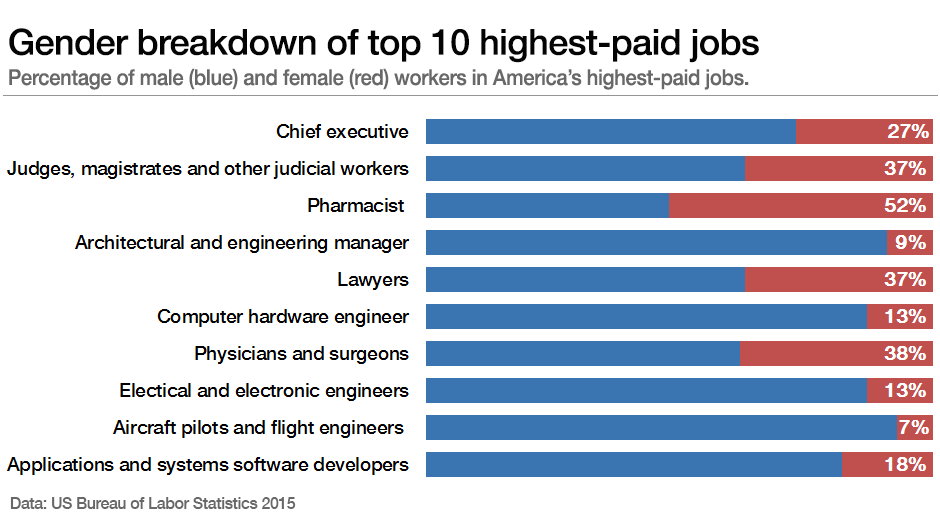The simple reason for the gender pay gap: work done by women is still valued less

Equal pay for equal work? Not yet Image: REUTERS/Ruben Sprich

Get involved with our crowdsourced digital platform to deliver impact at scale
Stay up to date:
Gender Inequality
Equal pay for equal work. It sounds so reasonable, it’s hard to believe that in 2016, we’re still talking about the gender pay gap. And yet the fact remains that there is no country in the world where women earn the same as men.
One of the arguments used to explain – and sometimes justify – this stubborn gap is the idea of choice. Women simply choose to study less lucrative subjects, enter lower-paying professions and stay towards the bottom rungs of the career ladder. While these choices might give them shorter working hours and greater flexibility, it also negatively affects their earnings.
The latest data from the US Bureau of Labor Statistics does indeed show that women are under-represented in some of the highest-paying occupations.

They also disproportionately make up some of the lowest-paid jobs.

It’s not that women engineers are getting paid less than men doing the same job: it’s that a childcare worker is getting paid less than an engineer, or so the argument goes. If that’s the case, the answer is simple: women should start moving into those careers that do pay well. Instead of becoming a social worker, become a software developer.
But that’s only part of the story. The fact is that even within those lucrative, male-dominated professions, the gender pay gap is still there. “There is a belief, which is just not true, that women are in bad occupations and if we just put them in better occupations, we would solve the gender gap problem,” Claudia Goldin of Harvard University told the New York Times.
As her research has shown, even when men and women do the same work, there’s still a gender pay gap – particularly in higher-paying jobs.

What can possibly explain this persistent pay gap?
Paula England, a professor at New York University and an authority on the gender pay gap, thinks it’s obvious: “It’s not that women are always picking lesser things in terms of skill and importance. It’s just that the employers are deciding to pay it less,” she explained in a different New York Times piece.
She’s not just saying this based on a hunch: along with Paul Allison of the University of Pennsylvania and Asaf Levanon of the University of Haifa, England has carried out one of the most exhaustive studies on the issue. Their findings suggest that women are not necessarily kept out of or choose not to enter high-paying and prestigious professions. Instead, when a job is dominated by women, it’s just not seen as important, and therefore pays less, even if it requires the same skills and education. The New York Times uses the example of janitors versus maids, jobs that are identical in every aspect except gender composition – and pay.

And as women start moving into traditionally male-dominated positions, the pay falls: “A 10% increase in proportion female is associated with .5% to 5% percent decrease in hourly wage in each decade,” the three researchers found.
The world of computer programming is the perfect example. Historically a female-dominated field, men started to take over in the 1980s. And as they did, things changed: “When male programmers began to outnumber female ones, the job began paying more and gained prestige,” Claire Cain Miller of the New York Times writes.
It’s not a new observation. Twenty years ago, Gloria Steinem was writing about the phenomenon: “Categories of work are less likely to be paid by the expertise they require – or even by importance to the community or to the often mythical free market – than by the sex, race and class of most of their workers.” But for a new generation of women who thought this was a thing of the past, it will be disappointing to see just how far we still have to go.
Have you read?
Don't miss any update on this topic
Create a free account and access your personalized content collection with our latest publications and analyses.
License and Republishing
World Economic Forum articles may be republished in accordance with the Creative Commons Attribution-NonCommercial-NoDerivatives 4.0 International Public License, and in accordance with our Terms of Use.
The views expressed in this article are those of the author alone and not the World Economic Forum.
The Agenda Weekly
A weekly update of the most important issues driving the global agenda
You can unsubscribe at any time using the link in our emails. For more details, review our privacy policy.
More on Equity, Diversity and InclusionSee all
Claude Dyer and Vidhi Bhatia
April 18, 2024
Julie Masiga
April 12, 2024
Alex Edmans
April 12, 2024
John Hope Bryant
April 11, 2024
Victoria Masterson
April 9, 2024






